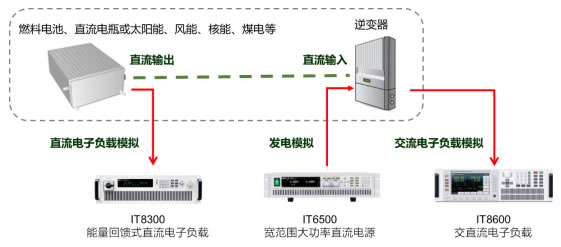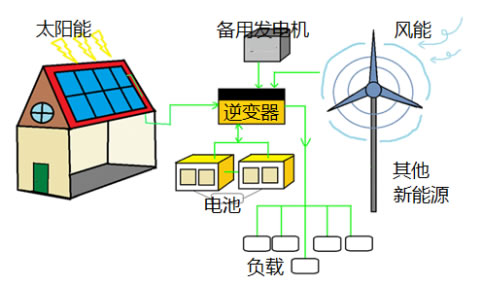Inverters convert DC energy (battery, battery) into AC (typically 220V/50HZ sine or square wave). Off-grid inverters are often used in new energy systems and are not connected to the public power grid. They are often used in emergency power sources at home or in offices. They are generally used to reverse DC batteries into 220V AC. There are also some remote area lodges or cars, cabins will also be used. The output of the inverter is also divided into sine wave and square wave output. The sine wave inverter outputs sine wave AC power that is as good as the grid we use everyday, because it does not have electromagnetic pollution in the grid. The output of the square wave inverter is a square wave alternating current with poor quality, and its positive maximum to negative maximum value is generated almost at the same time, thus causing severe instability to the load and the inverter itself. The object to be tested in this article is a sine wave off-grid inverter. As with grid-connected inverters, off-grid inverters also have a series of technical requirements and national standard test specifications. ITECH IT8615 AC/DC electronic load combined with IT6500 high-power Dc Power Supply to build the test system architecture shown in Figure 1, can complete all the following test items of off-grid sine wave inverter.

Figure I. Test diagram of inverter
Inverter efficiency
The inverter efficiency index is very important. The inverter with higher efficiency has less wasted electric energy, and more electric energy is used for electric appliances. Especially when using a low-power system, the importance of efficiency is more obvious. Therefore, the efficiency test of small inverters is particularly important. The efficiency of the inverter is the ratio of the inverter output power to the input power. If an inverter inputs 100 watts of direct current and outputs 90 watts of alternating current, then its efficiency is 90%.
GB/T 19064-2003 specifies that when the output power of the inverter is greater than or equal to 75% of the rated power, the efficiency should be greater than or equal to 80%. Larger inverters should also give full-load and low-load efficiency values. The efficiency of inverters below 10kW should be 80% to 85%. The efficiency of 10kW inverters should be 85%. %. The efficiency of the inverter has important influence on the photovoltaic power generation system to increase the effective power generation and reduce the cost of power generation.
IT8615 comes with AC power meter, which can measure Vrms, Vpk, Vdc, Irms, Ipk, Idc, W, VA, VAR, CF, PF, Freq and other parameters at the same time. It can cooperate with the pre-level DC power supply IT6500 without power meter. The efficiency of the inverter can be calculated.
Harmonic distortion
When the off-grid inverter output waveform is a square wave and a correction wave, the output current of the inverter has higher harmonics in addition to the fundamental wave, and the higher harmonic current will generate additional losses such as eddy currents on the inductive load. , causing severe heating of parts, is not conducive to the safety of electrical equipment. The harmonic distortion of a sine-wave inverter is less than 3%, and its waveform quality is better than that of a mains power grid and can be applied to all ac loads. The IT8615 measures up to 50 voltage harmonics at the inverter output.
Output voltage stability
It refers to the voltage regulation capability of the inverter output voltage. In the off-grid solar photovoltaic system, the battery terminal voltage fluctuates greatly during charge and discharge. Generally, the fluctuation of the terminal voltage of the lead-acid battery can reach about 30% of the nominal voltage. This requires the inverter to have better voltage regulation performance. Guaranteed normal operation over a large DC input range. High-performance inverters should also give the % deviation of the inverter's output voltage when the load varies from 0% to 100%, which is often referred to as the load regulation ratio or dynamic response. The voltage regulation rate of the inverter with good performance should be <±3%, and the load regulation rate should be <±6%. IT8615 can work in CC, CP, CR mode, adjust different load current, resistance or power, and can check the output voltage of the inverter in real time on the panel or PC software.
Starting performance
General inductive loads, such as motors, refrigerators, air conditioners, washing machines, high-power pumps, etc., may be 5 to 6 times the rated power at startup. Therefore, usually the inverter will withstand large instantaneous surge power when the inductive load starts. The inverter should ensure reliable starting under the rated load, and the high-performance inverter can be started multiple times at full load without damaging the power device. In order to be self-safety, small inverters sometimes require soft start or current limit start. The IT8615 can regulate cf up to 5, ie instantaneous power with 5 times the rated power of the load. Customers do not need to purchase large power load models with instantaneous power.
System output voltage and frequency
The working voltage that the inverter outputs to the load, single-phase inverter is generally 110V, 220V, 3-phase inverter is 380V; The output frequency stipulated in GB/T 19064-2003 standard should be between 49Hz and 51Hz. The IT8600 series supports input of 15-420V, frequency of 45-500Hz, single and three-phase input, and fully meets test requirements.
Maximum output power
The rated output power represents the ability of the photovoltaic inverter to supply power to the load. Photovoltaic inverters with high rated output power can bring more power loads. When selecting a PV inverter, first consider that it has enough rated power to meet the requirements of the equipment for electrical power under the maximum load, as well as the expansion of the system and the access of some temporary loads. When the electrical equipment is used for pure resistive load or the power factor is greater than 0.9, the rated output power of the photovoltaic inverter is generally selected to be 10% to 15% larger than the total power of the electrical equipment.
The provisions of the GB/T 19064-2003 standard require that the inverter be capable of continuous operation for a certain period of time under a specific output power condition.
(1) The input voltage and output power are rated values, and the inverter shall be continuously and reliably operated for more than 4 hours.
(2) The input voltage and output power are 125% of the rated value, and the inverter should work continuously and reliably for more than 1 min.
(3) The input voltage and output power are 150% of the rated value, and the inverter should work continuously and reliably for more than 10s.
IT8600 series electronic load has data recording function. The panel has a shortcut key log to record the current measurement data, and can be stored in the U disk and other peripheral storage devices.

Figure II. Energy flow diagram
Inverters can be divided into coal power inverters, solar inverters, wind energy inverters, nuclear energy inverters, hydroelectric inverters, fuel cell inverters, etc., depending on the power generation system. The 220V electricity that the inverter on the car obtains is 220V 50HZ, the high-grade spot is sine wave, the cheaper is generally square wave.
In addition to inverters, UPS uninterruptible power supplies, frequency converters, alternators, AC power supplies, etc. can also be tested using the test method at the output of the inverter. The IT8600 series AC/DC electronic load can adjust CF and PF values to simulate inductive or capacitive loads to facilitate testing.
